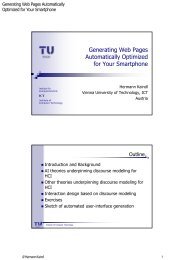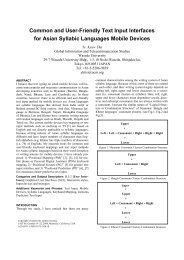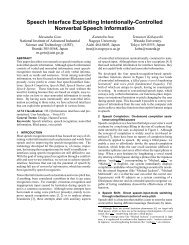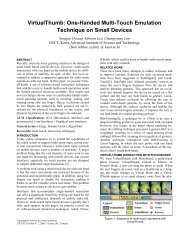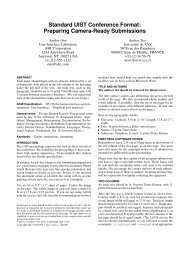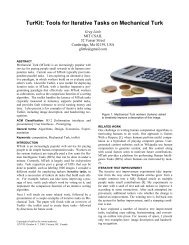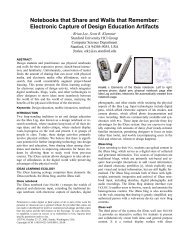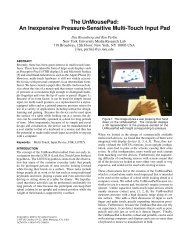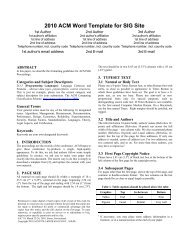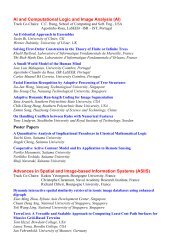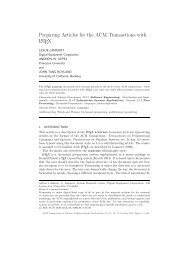API Design Matters Stonebraker and Seltzer - RabbitMQ
API Design Matters Stonebraker and Seltzer - RabbitMQ
API Design Matters Stonebraker and Seltzer - RabbitMQ
Create successful ePaper yourself
Turn your PDF publications into a flip-book with our unique Google optimized e-Paper software.
Toward a<br />
Commodity<br />
Enterprise<br />
Middleware<br />
est in improving middleware. Banks are still pushing the<br />
envelope with market data events exceeding 500,000 per<br />
second at source, according to the Options Price Report-<br />
ing Authority. Processing that flood of information <strong>and</strong><br />
executing timely business transactions off the back of it is<br />
challenging. Market data volumes exacerbate transaction-<br />
processing volumes.<br />
Given the clear need, why do many internal efforts<br />
not endure? Despite their technical abilities, banks are<br />
not software houses; messaging middleware is complex<br />
software, <strong>and</strong> it is difficult for a bank to focus the level of<br />
intellect <strong>and</strong> talent on the problem for a long time.<br />
Banks have managed to work together in creating<br />
open technical st<strong>and</strong>ards where such st<strong>and</strong>ards are<br />
absolutely necessary to doing business; the FIX (Financial<br />
Information Exchange) protocol, FAST (FIX Adapted for<br />
Streaming), FpML (Financial products Markup Language),<br />
<strong>and</strong> SWIFT (Society for Worldwide Interbank Financial<br />
Telecommunication) are all good examples.<br />
In 2003 I embarked on a quest to st<strong>and</strong>ardize MOM<br />
(message-oriented middleware) technology outside my<br />
firm, so we could pick it up inside the firm <strong>and</strong> use it<br />
between firms.<br />
MAkiNG iT HAPPEN<br />
This had to be an industry initiative. Home-grown<br />
middleware could not thrive in the small market available<br />
within a host organization, even the largest host.<br />
It is also notable that pervasive networking st<strong>and</strong>ards<br />
such as Ethernet, the Internet Protocol, e-mail, <strong>and</strong> the<br />
Web share some traits. They are all royalty-free <strong>and</strong> unen-<br />
cumbered by patents, they are all publicly specified, <strong>and</strong><br />
they all shipped with a useful early implementation for<br />
free. The combination of freedom <strong>and</strong> usefulness drives<br />
their adoption when predicated on fitness for purpose.<br />
To succeed, AMQP needed to adopt these same charac-<br />
teristics:<br />
• It needed to be a fully defined, open, royalty-free,<br />
unpatented specification to enable anyone to implement<br />
a compatible service. Furthermore, the st<strong>and</strong>ard specifica-<br />
tion had to be clearly separate from the implementations;<br />
otherwise, it would not be a fair market for commercial<br />
entities to enter. AMQP had to be appealing for com-<br />
mercial implementation <strong>and</strong> exploitation or it would not<br />
succeed.<br />
• AMQP needed to have real implementations of the<br />
specification; otherwise, the specification would not be<br />
immediately useful or interesting to front-line developers<br />
with pressing needs. Ideally, it should have more than<br />
one implementation to qualify as a potential IETF draft<br />
st<strong>and</strong>ard. 2 So, there are real implementations you can run<br />
today (as detailed later in the article).<br />
• AMQP software had to be proven in live systems.<br />
Middleware is a critical piece of any system <strong>and</strong> must<br />
be trusted. That trust has to be earned. To this extent, it<br />
was clear we would have to deploy an implementation<br />
in a high-profile, mission-critical application to assuage<br />
the fears of other early adopters. So, a combination of<br />
OpenAMQ <strong>and</strong> Qpid are live at JPMorgan, supporting<br />
2,000 users on five continents <strong>and</strong> processing 300 million<br />
messages per day.<br />
• Finally, <strong>and</strong> most importantly, AMQP needed to be a<br />
collective effort. Openness to partnership <strong>and</strong> the ideas<br />
of others had to be there from the beginning. To this end,<br />
we carefully selected a partner to co-develop the specifi-<br />
cation <strong>and</strong> implement the software. We chose iMatix, a<br />
boutique European development house that had clearly<br />
demonstrated a commitment to open source <strong>and</strong> sound<br />
ethics, <strong>and</strong> had a strong engineering background <strong>and</strong><br />
excellent writing abilities.<br />
Because the project was sponsored by a bank, it also<br />
had to “wash its own face,” as they say. This was not a<br />
research project. Through sheer good luck, there was<br />
a need to refresh some large systems with very specific<br />
requirements. This provided a tangible return for AMQP<br />
investment, so I was able to convince a forward-looking<br />
CIO that AMQP was the way to go.<br />
THE AMQP WORkiNG GROUP<br />
When the shape of AMQP had been worked out between<br />
JPMorgan <strong>and</strong> iMatix, <strong>and</strong> the basics of the specification<br />
forged in the heat of an initial implementation, the time<br />
was right to extend the partnership <strong>and</strong> encourage others<br />
to bring their talents to the specification <strong>and</strong> share own-<br />
ership of AMQP’s future.<br />
Strong governAnCe<br />
The heart of openness <strong>and</strong> trust in any group effort is<br />
effective governance. Exp<strong>and</strong>ing the group required a<br />
new contractual framework <strong>and</strong> a plan for the end game<br />
where AMQP could become a st<strong>and</strong>ard. Red Hat took the<br />
50 May/June 2007 ACM QUEUE rants: feedback@acmqueue.com



